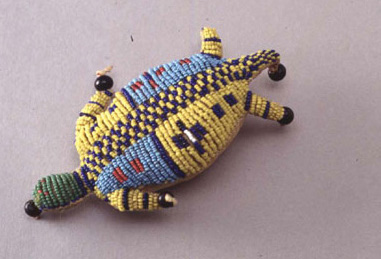
Click here to view image
Amulet, about 1875 (Teton Dakota)
Tanned cervid leather, vegetable fibre, glass count (covered stitch embroidery)
Amulet - turtle shaped container for umbilical cord intended for girls

Click here to view image
Amulet, about 1875 (Teton Dakota)
Tanned cervid leather, vegetable fibre, glass count (covered stitch embroidery)
Amulet - turtle shaped container for umbilical cord intended for girls

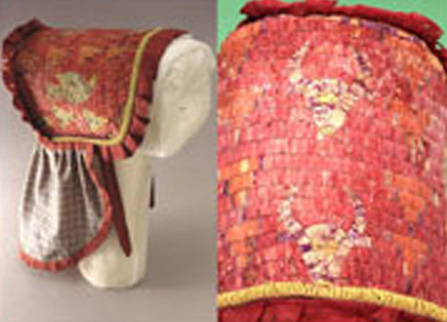
Click here to view image
Lakota headgear
Collezione Missioni Cattoliche Americane 1893
Lakota headgear
XIX - 1891 - 1900
C.A.356
Tipo di misura: lunghezza; Unità di misura: cm; Valore: 30; Varie: da fronte a nuca; Tipo di misura: larghezza; Unità di misura: cm; Valore: 18; Tipo di misura: lunghezza; Unità di misura: cm; Valore: 30
Sud Dakota
Gli aculei di porcospino venivano divisi a seconda della misura, ammorbiditi in bocca e, presso alcune tribù, spaccati; quindi erano appiattiti con i denti o con le unghie.
Protezione e ornamentale. Vita quotidiana.
Leather cap entirely decorated with porcupine quills drawing two bison heads in yellow and purple, two stylised ornithomorphic figures in yellow and light green and fourteen scaled triangles in green/yellow and orange/purple on a red background. The back of the cap is decorated with concentric squares in red, purple, green and yellow porcupine quills. The whole decoration is bordered by a band of purple porcupine quills and a band of yellow glass beads. The cap is entirely bordered with a strip of burgundy fabric and at the sides are sewn two burgundy fabric ribbons for fastening the cap under the chin. On the back is a blue and white checked cotton veil edged with a strip of burgundy fabric. The inside is lined with red and blue patterned fabric on a cream background. The bonnet was not part of traditional indigenous clothing; it began to be made on the model of those worn by white women. The model therefore followed the European one, but the decoration could be made from traditional materials, such as porcupine quills and glass beads.

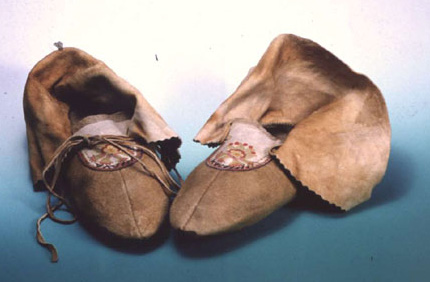
Click here to view image
Women’s loafers with floral decoration, 1885 - 1890 circa (Ojibway)
Tanned deer skin, animal fibre, silk thread, porcupine spines (flattened with teeth or nails, dyed and sewn): no traces of use


Click here to view image
Case for awl, 1870 - 1875 circa (East Dakota, Yankton or Santee)
Leather, wood, glass count (stitch embroidery "lazy", covering stitch and festoncino embroidery)
Pencil case for awl. It was carried by women hanging on the belt. Inside was kept a needle made from a bone splinter that was used to sew leather clothes. The embroidery identified the owner of the object

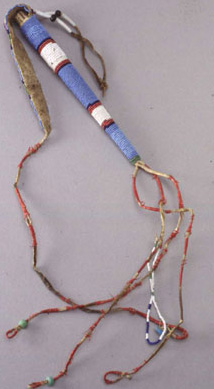
Click here to view image
Case for awl, 1870 - 1875 circa (East Dakota, Yankton or Santee)
Leather, wood, glass count (stitch embroidery "lazy", covering stitch and festoncino embroidery)

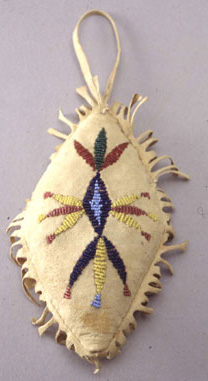
Click here to view image
Amulet, circa 1880, (East Dakota, Santee)
Leather, cotton thread, glass count ("lazy" stitch embroidery)
Amulet - container for umbilical cord intended for girls in the shape of a prism, with decoration that recalls a stylized turtle

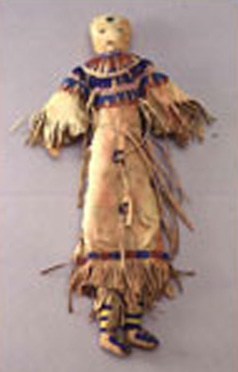
Click here to view image
Doll , 1880 circa (East Dakota)
Tanned cervid leather, fabric, wool, glass count ("lazy" stitch embroidery)
Doll. It was given to the girls at the age of one and a half. Usually it was made by the grandmother.

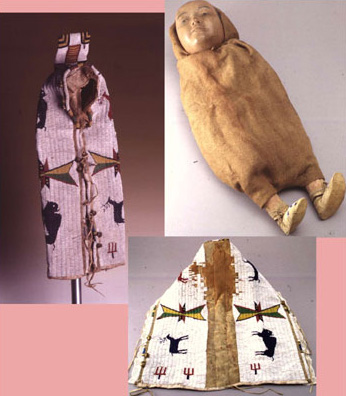
Click here to view image
vertical suspension cradle
Collezione Missioni Cattoliche Americane 1893
vertical suspension cradle
XIX - 1851
C.A.469/2
Sud Dakota (U.S.A.)
Si realizzava una struttura lignea composta di due asticelle in legno o si utilizzava un'asse che permetteva alla culla di rimanere rigida. Come copertura si utilizzava una pelle di cervide conciata, tagliata e cucita a mano in modo da formare una sacca priva della parte inferiore. Sui due lembi della parte superiore erano fissati dei legacci in pelle che permettevano di chiuderla intorno al bambino. L'esterno era decorato con aculei di porcospino che venivano divisi a seconda della misura, ammorbiditi in bocca e, presso alcune tribù, spaccati; quindi erano appiattiti con i denti o con le unghie. In un periodo più tardo, in seguito al contatto e ai conseguenti scambi con gli europei, gli aculei vennero sostituiti con conterie di vetro a formare motivi geometrici simbolici o decorazioni a figure zoomorfe. Per la conciatura la pelle veniva tesa su dei pioli e con un raschiatoio si eliminavano residui di carne e cartilagini, quindi veniva lasciata stesa al sole ad asciugare per parecchi giorni. A questo punto la pelle veniva capovolta per rimuovere il pelo, tenuta a mollo e strofinata con una mistura di grassi animali per ammorbidirla. Dopo averla lasciata nuovamente asciugare, veniva stirata e lavorata sulle due facce con una correggia ritorta di cuoio grezzo.
Ludica, predisposizione alla vita adulta. Porta-bebè. La madre vi poneva il neonato dopo aver imbottito il fondo di muschio, sterco di bisonte o pelo di coniglio, che avevano funzione assorbente. La culla veniva appoggiata o appesa per permettere alla madre di lavorare, oppure trasportata sulla schiena e fissata tramite una fascia di pelle che cingeva trasversalmente il petto e le braccia. Dai tre ai cinque mesi fino al momento in cui il bambino/a non muoveva i primi passi.
Indiani d'America: Fiori e vita dalle collezioni del museo etnografico Castello D'Albertis - Genova, Museo d'arte orientale E. Chiossone, 1996<br>Mostra d'arte precolombiana e di etnologia americana - Genova, Castello D'Albertis, 1972-1977
Deer skin bag lined with patterned fabric on a cream background. Decorated externally (except bottom) with glass beads in white (background), blue, red, green, yellow and blue to form zoomorphic (elk and bison) and geometric figures. The flaps are bordered internally by a double band of cream-coloured lace. Nine metal rattles and three dangling strands of metal conterie are attached along the outer edge. On the flaps are two leather ties on each side. On the bottom, to the part on which the child's head rested, is sewn a rectangular leather decorated entirely on both sides with white (background), red, yellow and blue conteries forming geometric patterns and parallel lines The mother would place the infant in it after stuffing the bottom with moss, bison dung or rabbit fur, which had an absorbent function. The cradle was either propped or hung to allow the mother to work, or carried on her back and secured by means of a leather band that encircled the chest and arms crosswise. The decorative geometric patterns, “many points” and parallel lines symbolize pregnancy scenes for the Dakota people; the trident motif symbolizes rain and the central symbol the four directions.

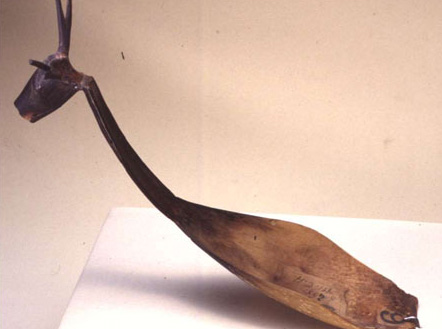
Click here to view image
Spoon, 1875 - 1880 circa (Oglala - Lakota or Brulee)
Ox horn
Spoon with deer/moose shaped handle terminal.

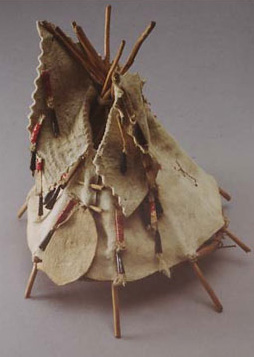
Click here to view image
Model of house, circa 1880 (Dakota - Teton)
Dehulled and curved wooden twigs, tanned cervid skin, porcupine thorns (flattened with teeth or nails, dyed and sewn), vegetable fibre, feathers and metal
Model of conical house of the natives of the Plains/Prairies (Tipi), toy for girls




Headquarters:
Municipality of Genoa - Palazzo Tursi
Via Garibaldi 9 - 16124 Genoa
C.F / VAT 00856920102